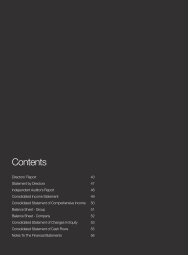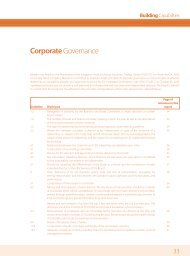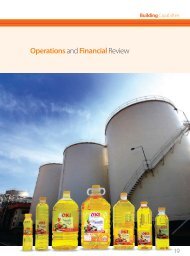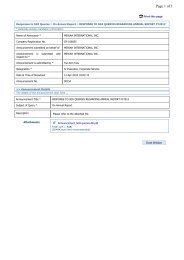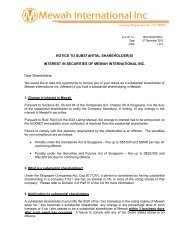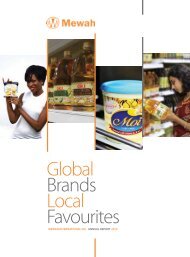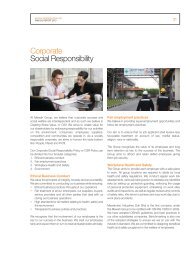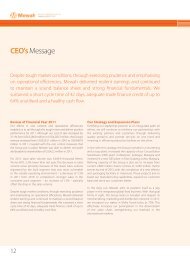FINANCIAL STATEMENTS - Mewah Group
FINANCIAL STATEMENTS - Mewah Group
FINANCIAL STATEMENTS - Mewah Group
Create successful ePaper yourself
Turn your PDF publications into a flip-book with our unique Google optimized e-Paper software.
ANNUAL REPORT 2012NOTES TOTHE <strong>FINANCIAL</strong> <strong>STATEMENTS</strong>For the financial year ended 31 December 20122. SIGNIFICANT ACCOUNTING POLICIES (CONTINUED)2.8 Borrowing costsBorrowing costs are recognised in profit or loss using the effective interest method except for those costs that are directlyattributable to the acquisition, construction or production of a qualifying assets. Capitalising of borrowing costs commences whenthe activities to prepare the asset for its intended use or sale are in progress and the expenditure and borrowing costs are beingincurred. Borrowing costs are capitalised until the assets are ready for their intended use or sale.Borrowing costs on general borrowings are capitalised by applying a capitalisation rate to the acquisition, construction orproduction of qualifying assets that are financed by general borrowings.2.9 Financial assets(a) ClassificationThe <strong>Group</strong> classifies its financial assets in the following categories: at fair value through profit or loss, loans and receivables,held-to-maturity, and available-for-sale. The classification depends on the nature of the asset and the purpose for which theassets were acquired. Management determines the classification of its financial assets at initial recognition and in the case ofassets classified as held-to-maturity, re-valuates this designation at each statement of financial position date.(i)Financial assets at fair value through profit or lossThis category has two sub-categories: financial assets held for trading, and those designated at fair value through profitor loss at inception. A financial asset is classified as held for trading if it is acquired principally for the purpose of selling inthe short term. Financial assets designated as at fair value through profit or loss at inception are those that are managedand their performances are evaluated on a fair value basis, in accordance with a documented <strong>Group</strong> investment strategy.Derivatives are also categorised as held for trading unless they are designated as hedges. Assets in this category arepresented as current assets if they are either held for trading or are expected to be realised within 12 months after thestatement of financial position date.(ii) Loans and receivablesLoans and receivables are non-derivative financial assets with fixed or determinable payments that are not quoted in anactive market. They are presented as current assets, except for those expected to be realised later than 12 months afterthe statement of financial position date which are presented as non-current assets. Loans and receivables are presentedas “trade receivables” (Note 14), “other receivables” (Note 15) and “cash and cash equivalents” (Note 17) on thestatement of financial position.(iii) Held-to-maturity financial assetsHeld-to-maturity financial assets, are non-derivative financial assets with fixed or determinable payments and fixedmaturities that the <strong>Group</strong>’s management has the positive intention and ability to hold to maturity. If the <strong>Group</strong> wereto sell other than an insignificant amount of held-to-maturity financial assets, the whole category would be tainted andreclassified as available-for-sale. They are presented as non-current assets, except for those maturing within 12 monthsafter the statement of financial position date which are presented as current assets.57



